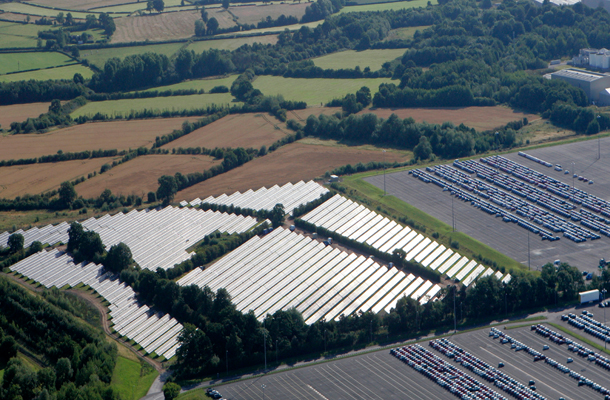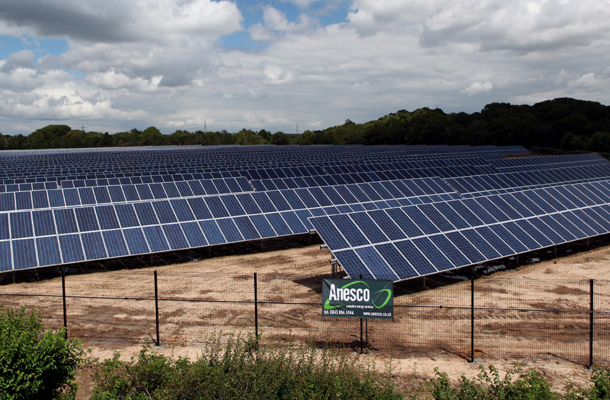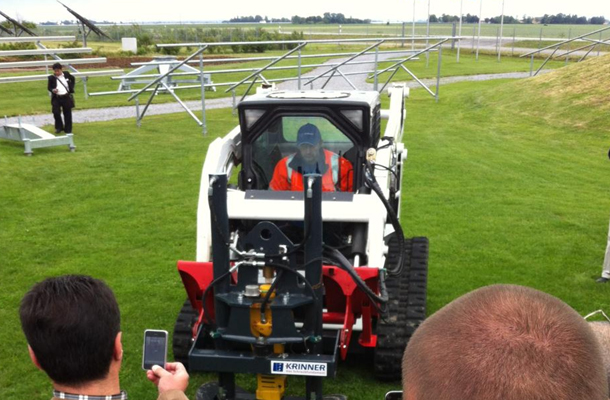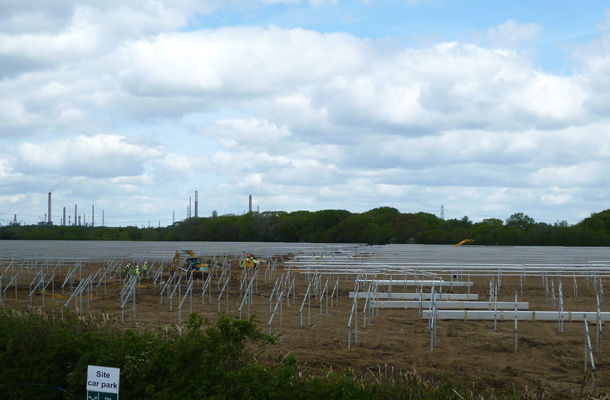Krinner ground screws provide ideal solution for roadside signage de-cluttering
Transport Secretary Patrick McLoughlin has exposed roadside signage in the UK countryside as cluttered, with excessive and “pointless” signs sprouting “like weeds”.
Mr McLoughlin said the problem is not just aesthetics, but the unnecessary signs create confusion and can be dangerous for drivers as well.
Krinner ground screws are an ideal solution to address the roadside signage clutter problem, as they are completely and easily removable, allowing for fast relocation and rotation of signs. The krinner ground screws are ideal for all sign installations, including passively safe installations and speed indication device programmes.
Used successfully on the UK network since 2006, krinner ground screws are safe, reliable and sustainable, as well as being much quicker to install than traditional concreting methods. A typical single sign installation using krinner ground screws can be completed in one shift – within 20 minutes of arriving on site.
In addition, both installation and removal have minimum impact on the landscape, as well as creating no spoil, waste or landfill.
Find out more about krinner ground screws and other uses within infrastructure.
Innovative ground screw makes significant contribution to renewable energy in the UK
The innovative Krinner ground screw has made a significant contribution to renewable energy in the UK since 2011, with almost 20MWp of energy generated through ground mounted solar, built on the sustainable ground screw foundation.
Over 22,000 ground screw foundations have been used to support in excess of 70,000 solar pv modules across numerous projects in the UK over the last 22 months, equating to around 1,000 ground screws and approximately 1MWp of energy per month.
A concrete-free alternative to traditional foundations, the 80% recycled ground screw has strong environmental credentials, as well as delivering unbeatable construction times. For example a project envisaged to take 12 weeks to build when using concrete foundations, can be completed in just 4 weeks.
The Krinner ground screw was also used to build two of the UK’s largest solar farms, including a 5MWp site in Hampshire and a 4.1MWp scheme at the Toyota plant in Derby.
As well as providing foundations for renewable energy technologies, the Krinner ground screw is also used as foundation for many applications, including highways and rail in the UK.
Krinner ground screws featured in Power and Energy Solutions Magazine
Krinner ground screws have been featured in the latest edition of the PES (Power and Energy Solutions) Magazine.
Supporting 10 per cent of the world market, Krinner ground screws are proven technology for solar PV. Krinner ground screws have been used widely across Europe over the last 10 years and have been the foundation of choice to install around 1GW of solar PV programmes, including two of the UK’s largest solar farms.
In this article, krinner ground screws are described as an innovative, robust and sustainable alternative to concrete. To read more about the benefits of using krinner ground screws as a foundation for a multitude of structural construction projects, please visit our About ground screw page.
—
As featured in Issue 21, 2012 (Europe Edition) of the PES (Power and Energy Solutions) Magazine (Solar), pp 86-88. Information correct at the time of print.
Steve Helliwell, director at JPCS, the innovative UK-based ground mounted solar PV construction expert, discusses the physical, technical and political challenges facing the ground mounted solar PV market.
Contrary to widely-held misconceptions, opportunities in solar energy in the UK are increasing. According to finance experts, there are more investors interested in funding large-scale ground mounted solar PV projects than ever before.
In the industry’s early years, development of the UK market was skewed more by government policy than market forces. The way forward for solar energy and other renewable technologies was seen as the proliferation of thousands-upon-thousands of small scale roof or garden installations, funded by ‘retail’ sources of finance.
Those who installed electricity-generating technology from a renewable or low-carbon source, such as solar photovoltaic or wind turbine, qualified for the government’s Feed-In Tariff scheme (FiT). Residential households, businesses, farms and small landowners could benefit from low cost energy generation and also have money rebated from their energy supplier for the surpluses they exported to the grid.
However, proposed changes to this government tariff triggered a period of considerable uncertainty. The reduced FiTs for solar PV systems came into effect on 3rd March this year, not 12th December 2011 as the UK Government had originally intended.
The UK Government has since announced that a further cost control framework for solar PV, reducing FiTs, will be in effect from 1st August 2012 and rates for other renewable energy technologies should be reduced, or stay the same, from 1st October 2012. Specifically:
- The new tariff rate for solar PV <4kWp will drop to 16p/kWh with an EPC band D or higher (if band E or less the lower tariff rate has also dropped to 7.1p/kWh).
- The export tariff rate will increase to 4.5p/kWh for all new solar PV installations.
- The tariff period (lifetime) will be reduced for solar PV from 25 to 20 years for all new solar PV installations.
These new tariffs are quite complex but the broad conclusion is that for those small operators, like homeowners and SME businesses, perhaps planning to erect a solar panel system on roofs and small plots, the limit of viability has been reached in all but the most sunny parts of the UK. As global fuel prices fluctuate and energy costs follow, many of these small schemes slip in or out of viability.
Biggest challenges in the market
The Government has worked hard to encourage green energy initiatives but sadly the Road Map it’s set out for achieving 30 per cent green energy by 2020 is already out of date. A heavy focus on offshore wind has meant other energy sources are not given due consideration. The fast pace of change in the sector means the reports and research the Government is conducting are out-dated before they are even completed. Up-to-date research is needed.
Unfortunately, public opinion is still a major stumbling block for green energy. We all want green energy in principle but we don’t want to have our roofs covered with solar panels, wind turbines outside our windows or the smell of biomass in transit. More education is needed to encourage the public to embrace green energy solutions.
New opportunities
However, research evidence suggests that there is significant demand for long-term investment in large-scale, mainstream ground mounted solar PV solar power schemes, where the return is based on producing sustainable, renewable energy specifically for sale to the grid. Installers focusing on FiTs alone may be missing out on other project opportunities.
No upper capacity limit
One alternative is Renewable Obligation Certificate (ROC) financing. Projects over 5MW are ineligible for FiT payments but will receive incentive payments under the Renewable Obligation Certificate.
ROCs are green certificates issued to operators of accredited renewable generating stations for the eligible renewable electricity they generate. The ROCs place the onus on UK electricity suppliers to source an increasing proportion of the electricity they supply from renewable sources, so they are funded by the energy suppliers themselves and not the Government.
Therefore, while the Government’s feed-in tariffs have been cut significantly, there is no capacity limit for systems funded under ROCs. Although there is limited awareness of this funding in the existing solar industry, many of the bigger players have pipelines of PV projects in place through ROCs. These tend to be those who see the ROC platform as the ideal ‘middle ground’ for investors, somewhere beneath the multi-million budgets of the wind turbine sector and above the uncertainties of small scale solar FiT model.
According to The British Photovoltaic Association (BPVA), the UK solar industry has reached an important and exciting stage in its development and has the opportunity, for the first time, to be the cornerstone of the government’s onshore renewable policy.
ROCs – the biggest opportunities in the sector
Where suppliers don’t have a sufficient number of ROCs to meet their obligation, they are required to pay an equivalent amount into a ‘buy-out’ fund. The administration cost of the scheme is recovered from the fund and the rest is distributed back to suppliers in proportion to the number of ROCs they produced in respect of their individual obligation.
ROCs produce their best savings on major energy plants producing 5MWp or more. As the cost of producing solar power has reduced significantly over the past few years, suppliers are no longer just looking at solar plants of just 30 acres – they are looking at sites of 300 acres or more.
Lower costs
This opportunity is also due to two other factors: significant cost reductions in the price of both solar modules and, importantly, improved installation techniques. In light of these developments the solar industry in the UK is now a cost-effective solution which compares favourably with other renewable technologies. Solar has the potential, using lower subsidies, to see to a significant increase in installed capacity over the coming years and to be a major part of the government’s 2020 renewable electricity target.
The 22GW target set and confirmed by the Government has the potential to transform the UK market in one of the most interesting energy markets in Europe over the next few years.
Cheaper installations
In the past, traditional, relatively expensive, time-consuming and environmentally damaging methods have often been used to install the frameworks to which solar panels are attached. This involved excavation, concrete foundation groundworks and back-filling: methods used for planting fence posts for generations.
Innovation in foundation systems has meant this is no longer the case, take the German-engineered ground screw system for example. ground screw is a robust and sustainable alternative to traditional concrete foundations for ground mounted solar pv panels. The system removes the need for excavation and concreting. Where you would usually cast small concrete pads, ground screw can be used instead.
In essence, a series of rigid, threaded, PVC columns are accurately screw-driven into the surface and subsoil to provide a robust, durable, non-invasive and secure footing for the panel-supporting structure.
Ground screw foundations are light in weight and easy to transport to the site. They have proved highly effective: sufficiently flexible to survive high wind loads and work in extremes of temperature or adverse chemical, biological and geological conditions, with the advantages of rapid installation and minimal maintenance.
The ground screw system is now widely used across the world market, playing a leading role in making the ground mounted solar industry commercially viable and attractive to investors. JPCS pioneered the installation for ground-mounted solar panels using ground screw and is now the UK’s largest specialist ground mounted solar PV installer.
JPCS has completed numerous green projects throughout the UK. These include the installation of comparatively small photovoltaic solar array projects, right through to some of the UK’s largest commercial solar PV ‘farms’. In 2011alone, the firm completed more than 20MWp of solar PV installations using this innovative ground screw foundation.
The big green future
Despite the challenges which lie ahead, the future for ground mounted solar mounted PV is bright. Great return on investments is there for those who have the green vision to develop large scale solar PV projects.
JPCS is a nationwide specialist renewable energy services contractor. Delivering services nationwide, it has a large portfolio of low-carbon energy projects contributing to a sustainable future. JPCS is also a leading provider of highways and rail services in the UK.
Read Issue 21 of PES magazine. This article is featured on pp 86-88.
Biggest UK solar farm built on the ground screw foundation
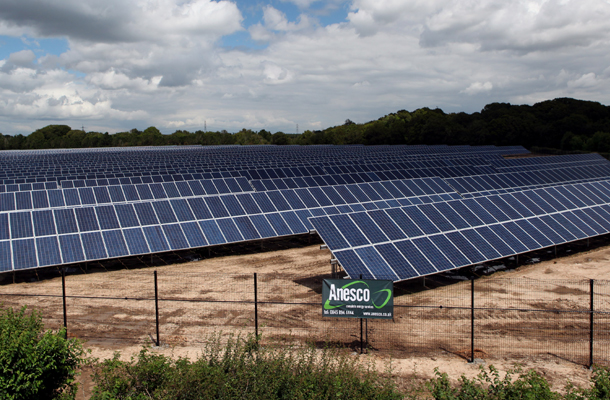
Krinner’s ground screw foundation has been used as the solution to install 18,000 solar panels in just four weeks, at the UK’s biggest solar farm on the Cadland Estate in Hampshire.
The 5MWp landmark 30 acre project was delivered for energy efficiency solution company Anesco at the Cadland Estate by Krinner UK’s exclusive installation partner in the UK, JPCS, the UK’s largest specialist ground mounted solar pv installer.
Almost 5,000 krinner ground screws were used as the foundation for the project, which is thought to enable the generation of enough electricity to power 1,000 homes.
Steve Helliwell, director at JPCS said:
“Our system removes the need for excavation and concreting. Where you would usually cast small concrete pads, a ground screw can be used instead.
“This came as a real benefit for the project as installation took place during the wettest June on record since 1910. The whole project would have been held up if installers had to wait for dry weather to pour the concrete. Using the ground screw foundation meant we could complete the project on schedule.”
Adrian Pike, CEO of Anesco who designed and managed the project, said: “Solar, along with the other technologies we deploy, are all key to creating a sustainable and mixed generation capacity for the UK, which is vital as we tackle the need to reduce carbon emissions.
“The site at the Cadland Estate blends different energy efficiency technologies together to bring the greatest benefit. It is not only helping to reduce emissions but is generating green energy, while creating jobs and long term revenue streams.”
The ground screw foundation system has been used to install over 20MWp of solar PV in the UK since the first trial installation in 2010. Krinner ground screws are also widely used across the world market, playing a leading role in the ground mounted solar pv industry.
As well as ground mounted solar, the ground screw foundation is also used for a variety of applications. Krinner UK is the nationwide supplier of the ground screw foundation, both on a supply only or on a supply and installation basis.
First anniversary of 4.1MWp solar farm installation in Derby with ground screw foundation
A landmark solar pv farm constructed on the innovative ground screw foundation, has celebrated its first anniversary this summer. The multi million pound project was undertaken by Krinner UK’s ground screw installation partner JPCS, for British Gas New Energy at the Toyota factory in Derbyshire.
Covering 90,000m2 of land, and featuring 17,000 solar panels, the ground mounted solar pv farm was built on 6,000 ground screw foundations and 8.65km of FLEXIII framing. One of the biggest solar farms in the UK manufacturing sector at the time, it was the first large-scale solar array for the UK car industry.
The innovative and exclusive ground screw foundation was critical in achieving the tight deadlines required for this project, in order to beat the changes to Government’s Feed-in Tariffs back in August 2011. Using ground screw for this project enabled the works to be completed in just four weeks, using an average of 24 skilled operatives, as opposed to a concrete foundation based project that would have taken approximately 12 weeks to complete.
Steve Helliwell, Director at JPCS said:
“The Derbyshire project was a fantastic achievement for JPCS last summer. We are really proud to have worked alongside clients like British Gas and Toyota and to have been involved in this project, which has led to other pioneering schemes.
Simon Baggaley, Head of Strategic Projects at British Gas Solar said:
“JPCS have supplied and installed ground screw and Krinner frameworks for several of our ground mounted solar PV projects, including the 4.1 MWp PV system at Toyota in Derbyshire. We chose JPCS as our partner for these projects because they demonstrated strong technical knowledge and a sound approach to project planning. During construction JPCS have lived up those expectations, and further delivered for us by providing great lead times, great service and great flexibility in their ability to apply resource. All the projects we have worked together on so far have been delivered on time, and with the best safety record of all our subcontractors.”
This fast forward video shows how the ground screw foundation was used to construct this solar pv farm:
Ground screw – so how does it work?
The Krinner ground screw is an innovative solution for ground foundation projects that requires no excavation and no concrete, with excellent results and exceptional value for money.
These short videos explain the process involved in the installation of the ground screw for ground mounted solar projects, and just some of the benefits of the ground screw as an alternative to concrete foundations:
Krinner ground screws World Alliance Meeting brings together world partners
The fourth Krinner World Alliance Meeting took place in Germany in early June, bringing together krinner ground screw partners from all over the world.
Held over three days in early June, the conference provided an opportunity for Krinner partners worldwide to meet and share best practice about the krinner ground screw. As well as an overview from Mr Sauter, Krinner’s CEO, of the Krinner organisation and a range of presentations – including Krinner UK’s installation partner JPCS – delegates also took a cruise down the Danube into Austria!
Some of the presentations and issues discussed included:
- Technical descriptions of use of trusses to deal with bending moment loads. This is particularly relevant for tracking concentrated solar arrays
- Introduction of a new software package which measures and records installation torque for screws. This also allows the data to be downloaded and analysed in Excel or visualised in graph form
- A new KRM measuring, pre-drilling and screw installation tracked robot. The robot is a great innovation and can be operated without a driver!
- Introduction of a hydraulic hammer rig for spiking hard ground up to 1.7m deep, solving some of the associated issues
- Unveiling of a new ground screw for road signs – the E-series. This new ground screw provides a single installation interface for multiple screw head configurations, which enables various diameters of circular post, various sizes of rectangular post, and bespoke post cross-sections
- An outline of Krinner’s internal programme, “Foundation For the Future”
- A demonstration of machines and techniques, including the spiking rig (pictured above) and the KRM robotic rig, on Krinner’s demo park.
Another highlight was the importance of communication and collaboration amongst kirnner ground screw world partners and the role of social media. Krinner ground screws uk’s social media management – with Twitter feeds in particular – was held up as a model for good practice!
Peter Shone, managing director of Krinner UK’s installation partner JPCS, said: “It was a pleasure and a privilege to attend the Krinner World Alliance Meeting. It was great to see such excellent representation from all the world partners – a good opportunity to share best practice between partners who are using Krinner products in a variety of applications.”
Krinner UK supplies the innovative ground screw product, both on a supply only or on a supply and installation basis. An alternative to traditional concrete foundations, krinner ground screws have a wide range of applications and benefits.
5,000 krinner ground screws used for 5MWp solar farm in the UK
5,000 krinner ground screws were the chosen foundation for one of largest ground mounted solar pv farms in the UK.
Working with Anesco, Krinner UK partner and ground mounted solar PV construction expert, JPCS has started work on the 5MWp project, one of the largest ground mounted solar pv farms in the UK. As a foundation to 18,000 solar PV panels, the site will see the installation of 5,000 krinner ground screws and nine kilometres of frame, covering 30 acres of farmland. The landmark project will generate enough electricity to power 1,000 homes.
The installation of the krinner ground screws and mounting frames started in May at the Cadland Estate near Southampton, with completion anticipated for early summer 2012.
Steve Helliwell, director at JPCS said:
“We are excited to be the chosen installation partner for a project of this scale. With the recent changes to Feed-in-Tariffs, we believe the biggest opportunity in the green sector at the moment is ROC funded energy plants.
“ROCs produce their best savings on major energy plants producing 5MWp or more. As the cost of producing solar power has reduced significantly over the past few years, suppliers are no longer just looking at solar plants of just 10 acres – they are looking at anything up to 300 acres.”
CEO of Anesco, Adrian Pike, said:
“This is a landmark project for Anesco and we continue to lead the way when it comes to energy efficiency solutions for industry, manufacturing, local authorities and homeowners.
“This project is not only helping to reduce emissions but is generating green energy for the local area as well as creating jobs and long term revenue streams.”
The innovative krinner ground screws were chosen as the foundation system for this leading green energy project. Krinner ground screws are a robust and sustainable alternative to traditional concrete foundations for ground mounted solar panels.
The system removes the need for excavation and concreting. Where you would usually cast small concrete pads, krinner ground screws can be used instead.
The Krinner ground screw is widely used across the world market, playing a leading role in the ground mounted solar industry.
New website for Krinner UK!
Krinner UK, the nationwide supplier of krinner ground screws in the UK, is delighted to announce the launch of a brand new website!
The website contains a host of information, including the wide range of ground screw applications, case studies, and latest company and industry news!
We would love to know what you think about our new website! Please take a moment to email us to [email protected]
DECC announces new solar pv FITs
Following the latest phase of consultation, the Department of Energy and Climate Change (DECC) has announced the new solar pv Feed-in Tariff rates.
The new rate for 4kW systems will be set at 16p/kWh, aligned with existing installation figures, in a bid to re-establish consumer confidence and to generate attractive return on investing as initially intended.
As expected, the DECC has also confirmed that the new FiT rates will now apply from August 1, to encourage further demand, with the original deadline set as July 1. A consequence of declining installation prices – in excess of 50 percent reductions over the last 2 years – as well as decreased demand and reduced installations from approximately 71MW to 17MW each month, the delays were welcomed across the solar industry.
The DECC expects that the new rates will boost investment in the solar market, aiming for installation figures to total 800MW over the next 18 months, as well as up to 1,000MWp each year to 2015, and a total of 22GW for 2020, despite a reduction from the original rates. In addition, larger schemes under ROCs could generate a further 300-600MWp of installations by April 2013.
Greg Barker, Minister of State, also announced additional changes to the current FiT scheme for solar pv, including:
- A less complex degression management model, including reduced quarterly degressions
- Three different bands for uptake: domestic (0-10kW); small commercial (10-50kW); and large commercial (above 50kW and standalone installations). Reductions will be established within each bands and applied on a quarterly basis
- New FiT rates to be paid over 20 years
- Return on investment is expected to be over 6 percent for conventional schemes, with up to 8 percent for the larger bands
- Export tariffs will increase from 3.1p to 4.5p, to boost large scale solar pv investor income
- Organisations with more than 25 solar pv installations will now receive 90 percent of the standard applicable tariff.
Mr Barker said:
“I want to send a very clear message today. UK solar continues to be an attractive proposition for many consumers considering microgeneration technologies and that having placed the subsidy support for this technology on a long-term, sustainable footing, industry can plan for growth with confidence.”
Meanwhile, the DECC has also published the long anticipated draft energy bill, which includes the Electricity Market Reforms (EMR), aimed at helping the UK to decrease reliance on conventional fuel and work towards a low carbon economy. The EMR posed keeping the lights on, reducing consumer energy bills, and generating clean electricity to address climate change as the most significant issues it aims to tackle. The reforms are expected to provide investors with transparency, longevity and certainty, in the hope to attract around £110bn investment to the UK.

